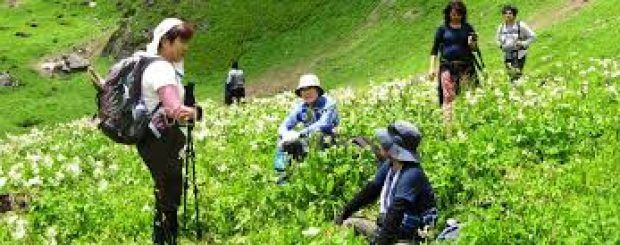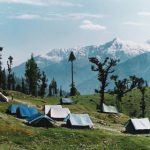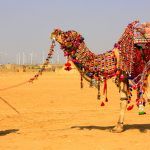Valley of Flowers Trekking Package
Day 1: Arrive Delhi
Meeting and assistance on arrival at International airport & transfer to hotel.
Delhi: India’s capital and major gateway to the country, contemporary Delhi is bustling metropolis, which successfully combines in its fold the ancient and the modern. Its Strategic location was one of the prime reasons why successive dynasties chose it as their seat of power. It is not surprising then that what constitutes Delhi today is a conglomerate of seven cities. Down the ages the region in and around modern Delhi saw Lalkot built in the mid-11th century, Siri established by Allauddin Khilji, Tughlakabad, and Ferozabad built by the Tughlaks followed by the city of the Lodis and then came Shahjahanabad, capital of the Mughals under Shah Jahan.
New Delhi reflects the legacy the British left behind, distinction between the capitals of the British and the Mughals respectively. But wherever the visitor goes he will invariably confront the city’s past.
The throbbing present of Delhi pulls one out of reflections on a mute past. The divisions in the walled city and New Delhi also mark the varied lifestyles. The walled city is all traditions, where as New Delhi in contrast, is a city living up to contemporary international standards. Delhi also serves as the major gateway for touring the internationally known tourism destinations of Agra and Jaipur.
Day 2: Delhi – Rishikesh (By Surface)
Morning after breakfast, leave for Rishikesh. Arrive Rishikesh and check in at your hotel. Afternoon guided tour of Rishikesh, a town of temples, Ghats and the Ganges.
Rishikesh: The Garhwal region of north India is speckled with some of the holiest of Hindu pilgrimage sites and Rishikesh is one such major attractions. Crowded with sadhus with long matted hair and pilgrims from all over the globe, Rishikesh is the birthplace of yoga. The various Ghats and temples assist the human spirit in its endeavour to be one with the ultimate source of all creations. It is also an attraction for the ones in search of adventure and passion.
Rishikesh abounds in temples. Most of the pilgrims who pass through Rishikesh on their way to the Himalayan shrines of the Char Dham pause for a holy dip and puja at Triveni Ghat, in the central part of the town. The river here looks especially spectacular during aarti (evening worship) when diyas or oil lamps float on the water. Nearby is the Bharat Mandir, Rishikesh’s oldest temple, dedicated to Lord Vishnu.
The Chandreshwar temple stands at the confluence of the Chandrabhaga and the Ganges. The Hanuman Mandir is flocked by a large number of devotees on Tuesday.
The dense-knit complex of cafes, shops and ashrams collectively known as Swarg Ashram, opposite Shivananda Nagar, is the most attractive part of Rishikesh, backing on to forested hills where caves are still inhabited by sadhus or hermits. The large courtyard of the Parmarth Ashram here is crammed with brightly clad statues of gods and goddesses.
Around 2 km north of Swarg Ashram, a path skirts the east bank of the river en route to Lakshman Jhula. The Lakshman Jhula is a 450-feet-long suspension bridge and was built in 1939. The Lakshman Temple on the west bank has been built to commemorate the journey of Lakshmana across the river on a jute rope. Many of the temples and ashrams around both ends of the bridge, such as the extraordinary Kailashananda Ashram, with each of its thirteen stories dedicated to a different deity’s are always filled with devotees. It is a pleasant 2-km walk from this place to the Shivananda Jhula.
Day 3: Rishikesh – Joshimath (By Surface)
After early breakfast leave for Joshimath en-route stop at Devprayag to witness the confluence of river Alaknanda and Bhagirathi to form holy river Ganges. On arrival, check in at your hotel.
Joshimath: A popular centre of pilgrimage, Joshimath has a tourist bungalow, hotels and dharamshalas. It is the base for trekking to the famous Valley Of Flowers. The season here is short lived: it starts from mid-July and lasts till end-August.
Day 4: Joshimath – Govindghat – Ghangaria (By Surface / By Trek)
After breakfast one hour drive to Govindghat, a small hamlet situated on the confluence of Alaknanda & Laxman Ganga. Arrive Govindghat and commence trek to Gangharia. Arrive Ghangaria and camp.
Ghangaria is a beautiful small village on the way to Hemkund sahib, a popular pilgrimage site for Sikhs and Valley of Flowers, a national park known for its variety of flowers. It is located in the northern Himalayan ranges at an altitude of 3049 meters in Uttarakhand state of India.
Ghangaria is situated on the bank of river Pusphavati also known as Laxman Ganga. It is the last human habitation in this tiny valley. This place is usually used by travelers as a base camp to visit Hemkund and Valley of flowers. It remains open only through the month of May till September with rest of the year covered less than 8 feet snow.
Day 5: Ghangaria – Valley of Flowers – Ghangaria (By Trek)
Trek to the valley of flowers. The first part of the trek is through thick forests and later we come to an open meadow. Arrive and explore the area. After seeing some rare flowers, we trace our steps back to Ghangaria.
Day 6: Ghangaria – Hemkund – Ghangaria (By Trek)
Trek to Hemkund, the pilgrimage for Sikhs as well as Hindus. On a clear day one can see the panoramic view of mountain peaks and the valley. Explore the area and trek down to Ghangaria for overnight camping.
Day 7: Ghangaria – Govindghat – Badrinath (By Trek / By Surface)
Trek down to Govindghat and from here drive to Badrinath, one of the four most important pilgrimages of Hindus.
Badrinath: Cradled in the twin mountain ranges of Nar and Narayan is the holiest of the four main shrines, Badrinath along the left bank river Alaknanda. With the splendid Neelkanth mountains as the backdrop, it is an important destination on the scared itinerary of every devour Hindu. Once the spot was carpeted with ‘badris’ or wild berries and hence was famous as ‘Badri Van’.
Badrinath is considered the holiest of the four important shrines in Garhwal. The town is at an altitude of 3,133 m. above sea level, situated on the left bank of river Alaknanda and exactly between the two mountains Nara and Narayan. The shrine is dedicated to Vishnu, the preserver and falls in the religious itinerary of every devout Hindu.
The present temple was built about two centuries ago by Garhwal Kings. It is a conical structure, 15 m. tall and has small cupola of a gilt bull and spire. There are 15 idols in the temple complex, each sculpted in black stone. The principal idol represents Vishnu in a meditative posture and is flanked by Nara-Narayan. Legend dates it prior to the Vedic age though it is believed to have been re-established by Adi Shankaracharya, an important Hindu saint in 8th century A.D. Some of the other images include Laxmi (Vishnu’s consort), Garud (Vishnu’s mount), Shiva & Parvathi and Ganesha.
Day 8: Badrinath
Day free to walk towards the base of Neelkanth peak and visit the temples.
Day 9: Badrinath – Auli – Joshimath (By Surface)
Drive to Auli and witness Mt. Nanda Devi and other peaks. Explore the area and drive down to Joshimath for meals and overnight stay.
Day 10: Joshimath – Rishikesh (By Surface)
After breakfast, drive down to Rishikesh. Arrive Rishikesh and check in at hotel.
Day 11: Rishikesh – Delhi (By Surface)
After breakfast, leave for Delhi. On arrival, check in at hotel. Afternoon combined city tour of Old & New Delhi with drive through the Raisina Hills- Parliament House, India Gate, President House; 16th century tomb of Emperor Humayun built of Marble & Red stone in typical Mughal fashion and visit to Qutab Minar, Raj Ghat, and the cremation site of Mahatma Gandhi.
Day 12: Departure Delhi
In time transfer from hotel to international airport to connect flight for onward destination / home.
Valley of Flowers Trek, Valley of flowers trek itinerary, valley of flowers trekking package
Social Share
Adventure Tours
Dharmasala Trek
Camel Safari in Rajasthan
Fishing Tour in India
Desert Adventure Tour
Northern India Adventure
Contact Us
Prish India Tours
(A unit of Prish Tours Pvt. Ltd.)
139, First Floor, Vardhman Crown Mall, Plot No. 2, Sector 19, Dwarka, New Delhi – 110075, (India).
+91 11 4166 1466
+91 98104 07877, 98109 30054






